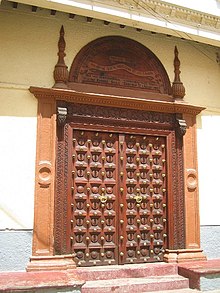User:Anitabath125
Character of Islam in Africa
[edit]Regional Description
[edit]In the Swahili coast region of Africa, which includes the some coastal parts of Somalia, Kenya, Tanzania, Mozambique, and Madagascar, there has developed a unique syncretistic, Islamic traditon. With early trade contact with the Arabian peninsula and Indian Ocean traders, the Swahili people have a cosmopolitan religous character that mixes these two influences with its traditonal African customs. Swahili Muslims are characteristically orthodox. Historically, jihad has not been a major theme for Swahili Muslims in their contact with the non-Muslim people of the interior. It was only once the Europeans arrived that the spread of Islam and the language Swahili began to penetrate the interior regions.[1]
Central and South Africa
[edit]Muslims make up very small percentages of the population in Central and South African countries, excluding the coastal regions of some East African countries. South Africa, the eastern areas of the Democratic Republic of the Congo, and Uganda have the largest of these countries. Islam first arrived in South Africa through a Muslim prince, sent there as an exile from Indonesia. The majority of early Muslims in South Africa were workers from India and Indonesia, who settled in and around Cape Town. After the fall of apartheid, Islam began to spread to the indigenous Africans. South African Muslims see themselves as a larger part of the ummah; and they live in a secular state which currently does not have Sharia law.The small Sunni Muslim communities in the Congo and Uganda are minorities when compared to the Christians and traditionalists. [2]
Visual Culture
[edit]Along the Swahili Coast, the Islamic presence manifests itself in a wide variety of modes, ranging from architecture to functional objects.Every Swahili town has a mosque which often includes a madrasa for religious education.

Many wealthy Swahili traders have paid for many of the ornate mosques that dot the coastline. Swahili architecture is a mix of Islamic and Indian forces because of their trading contacts. Since Islam discourages portraits or images of living things, Swahili art uses intricate, complex patterns.These patterns decorate rugs, ships, chests, and walls.Swahili women will draw intricate henna tattoos as a way of purification. Swahili men wear amulets which contain Quranic verses. [3]
Legal Traditions
[edit]The majority of Swahili Muslims are Sunni-Shafi’I; however there is also some influence from the Ibadi-Kharjite school because of the Omani rulers in Zanzibar. In the Swahili religious tradition there are two main concepts, the mila and the dini. Dini is the orthodox Islamic tenets which include the Quran, Hadith, and other legal texts. The mila focus more on relations with spirits and ghosts.<[4]
Sufism
[edit]Along the Swahili coast, Sufi brotherhoods have emerged. The Qadiryya and the Shadhiliyya are the most popular and are centered on gaining spiritual connectedness and knowledge of god through a self-induced dhikiri, or trance. Sufi groups have been important in their conversion of interior peoples to Islam.[5]
Medicine and Oral Culture
[edit]The Swahili believe in many different kinds of spirits or majini, each species with its own purpose and agenda. For example, the pepo za nyumbani are a family of spirits that occupy a home and are seen as spiritual protectors of the human occupants. However, the humans appease the family of spirits. If the spirits become malevolent and posses the occupants; they either recite Quranic verses or wear special white clothes to force the spirits out. Many illnesses, both physical and mental, are attributed to the random spirits. Often the Swahili will consult doctors or fundi, join a special group of possessed people led by a fundi who has overcome his possession, or wear amulets.[6] Medicine in some areas of the Swahili Coast is practiced with a mixture of traditional healing methods and Islamic spirituality. Islamic humorism is a theory that physical illness can stem from issues in spirituality. Practitioners of this humorist approach sometimes claim to be a Sharif, or a descendant of the prophet, which is thought to give them special healing powers. They provide homemade medicines and consultations to cure internal imbalance to try to relieve external symptoms. Humorism is sometimes used as supplement for more modern medical practices to cure malaria to high fevers. In recent decades, more conservative Sunni elements have labeled these practitioners as sorcerers and non-Islamic, and suggest the daily reading of the Qur'an as a substitute to these healers.[7]
References
[edit]- ^ Muslim Societies in African History, 36.
- ^ Platvoet, Jan, James Leland Cox, and Jacob Kẹhinde Olupọna. The study of Religions in Africa past, present and prospects . Cambridge, Eng.: Roots and Branches, 1996, 294-296.
- ^ Book of peoples of the world: a guide to cultures, By Wade Davis, K. David Harrison, Catherine Herbert Howell,57.
- ^ Horton, Mark, and John Middleton. The Swahili: the social landscape of a mercantile society. Oxford, UK: Blackwell Publishers, 2000, 190.
- ^ Middleton, John. The world of the Swahili: an African mercantile civilization. New Haven: Yale University Press, 1992, 170
- ^ Middleton, John. The world of the Swahili: an African mercantile civilization. New Haven: Yale University Press, 1992, 172
- ^ http://www.jstor.org.nuncio.cofc.edu/stable/pdfplus/649190.pdf?acceptTC=true,306
